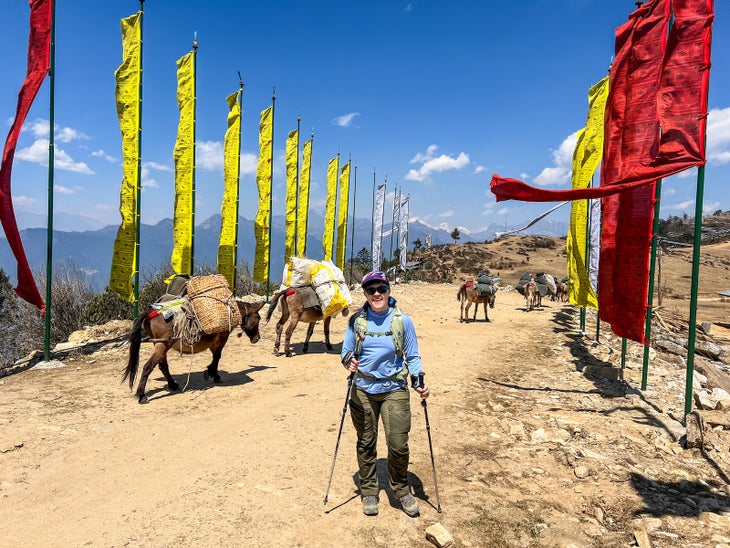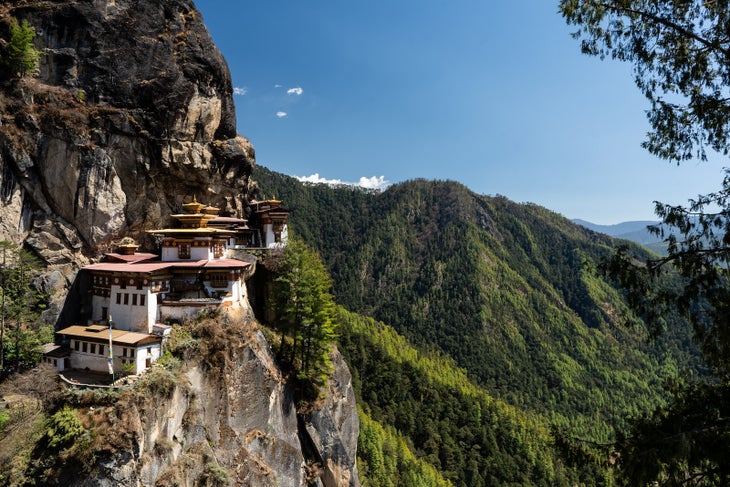“], “filter”: { “nextExceptions”: “img, blockquote, div”, “nextContainsExceptions”: “img, blockquote, a.btn, a.o-button”} }”>
Heading out the door? Read this article on the new Outside+ app available now on iOS devices for members!
>”,”name”:”in-content-cta”,”type”:”link”}}”>Download the app.
The hand-painted façade of the cliff’s edge Phajoding Monastery catches my eye as I tramp down a steep, dusty trail overlooking Thimphu, the capital city of Bhutan. It’s a welcome sight after three days of backcountry trekking through the Himalayan foothills, dragging my body and backpack up and down a series of uncompromising steeps speckled with blue pine and rhododendron forests. But the moment I spot the temple, my eyes spill open and tears unexpectedly stream down my face. Not happy tears: I don’t want to be here. Even though the appearance of this auspicious religious site should bring me joy, all I can do to keep shuffling my feet forward, as loneliness grips the very core of my being, is cry.
As an only child and an independent-to-a-fault personality, solo travel is one of the things I’ve always been inherently good at. I’ve hiked the John Muir Trail, road tripped across America, and traveled to all seven continents, all primarily alone. I’ve always found it thrilling to strike out into the great unknown with nothing but my wits and hiking boots in tow, gleaning a deep satisfaction from the chance meetings and unpredictables I encounter on my solo trips. But my perspective was forever changed after a slog through the mountainous kingdom of Bhutan.
The 34-mile Druk Path Trek is considered one of the easier backpacking adventures in the country, able to fit into a compact four- or five-day itinerary with plenty of time left over for exploring the vibrant cultural sites and centuries-old farms that make the country so unique. However, given its ultra-remote perch in the high Himalayas, Bhutan goes hard when it comes to trekking, as I soon learned when I met my guide and porters that first day.
The trip started out innocently enough. Our team of adorable, petite pack horses ran up the forested trail as morning light glistened against mossy stupas lining our ascent. Though the trail starts at a dizzying 9,500 feet, I was feeling strong as I steadily climbed toward Jela Dzong, a 500-year-old temple perched on a high hilltop over 11,000 feet that overlooks the Paro Valley.
A grizzled older monk with laugh lines up to his ears meandered over to my group and asked if we’d like a tour of the temple’s inner sanctum, and I quickly accepted. No photographs are allowed inside Bhutan’s ornate monasteries, keeping their customs and rituals shrouded in secrecy. Unlike the streamlined, minimalistic zen centers in the States, many Himalayan countries practice an intensely ceremonial sect known as Vajrayana Buddhism. It’s famous for its portrayals of wrathful gods and intensely detailed paintings of both Buddha and the Wheel of Samsara. I quietly strolled around the centuries-old artworks inside Jela Dzong, kneeling at the center of this precious space to ask the deities for safe passage.
Hundreds of streamers of multicolored prayer flags burst outward from the temple, making my final ascent a lively one as I huffed and puffed to a final elevation of 12,400 feet and set up camp. Happy to read on my own for a while, I watched the sunset across what felt like a never-ending tapestry of peaks and valleys. Dinner was a hearty display of white rice, sautéed greens and delicately sauced chicken thighs, made only slightly weird by the fact that my porters stashed me in a drafty tent to eat it alone. Then, night set in.
To be honest, I wasn’t terribly surprised when a gnarly headache started creeping across my scalp. Our ascent of over 3,000 feet had been an ambitious first day, even for a seasoned backpacker like me. On top of the altitude, the cold temperatures knocked me down several pegs. I had done my best to research daytime highs and lows in every locale I’d be visiting, but evening temperatures in the rural mountains of Bhutan were so difficult to predict that even my trekking company had not adequately prepared me for the frigid nights. I tossed and turned for hours in the subfreezing air, wishing that my partner was there to help keep me warm, or, at least laugh off the discomfort.

Groggy and exhausted from a night of poor sleep, I inhaled a breakfast of fried eggs and muesli before asking my guide about the logistics of our remaining days. “I only brought a 20-degree sleeping bag, and I don’t think it’s going to be enough as we keep ascending,” I explained. Compelled by a rough night in an ice-cold tent, I formulated a plan with my trekking guide: We’d bust our butts on day two, hiking nearly double the planned distance so that I could cut the trip short and complete the journey in three days, rather than four. The thought of spilling this wild tale to my boyfriend the moment I returned to town bolstered my eagerness to hike quickly.
Even so, the route was perilous and slow-going. Wearing every layer of clothing I’d brought, I had only my spiraling thoughts to contend with as we climbed to the top of a steep ridgeline with a sweeping view of 24,035-foot Jomolhari, the second-tallest summit in Bhutan. My guide chose to walk a full 100 feet ahead of me all day, staying largely silent as we strolled. “Why am I spending my precious vacation time hiking alone in the freezing cold?” I thought to myself as my lungs heaved on the intense uphill.
I dodged piles of yak dung on the arid path down to Jimilangtsho, a shimmering alpine lake bordered by jagged, frozen waterfalls that typically serves as night two’s campsite for most trekkers. For us, it was a brief lunch stop as clouds rolled in and temperatures plummeted. Because my guide still wasn’t talking much, I wrestled with my thoughts all alone. It didn’t take long for the tears to come.
Playing in the mountains is a funny pastime. When the weather’s good and you’re with your crew, there’s nothing better in the world. Twelve-hour days fly by in a blur of candy bars and Backpacker’s Pantry meals, and you find yourself laughing uncontrollably at the dumbest stuff, like a fat marmot trying to cross a log bridge. But alone in inclement weather? You’ll quickly feel your smallness and mortality as wind and cold pummel your tired body.
A fog enveloped the valley, turning the air milky white and chilling me to the bone, as we made our final ascent to Simkota Tsho. This sapphire tarn sits at a lofty height of 13,500 feet, and by the time we arrived, I could barely see my hand in front of my face or make out my tent in the rapidly darkening night. I stomached a few bites of dinner before making a beeline for my sleeping bag to journal and read. Bhutan had been at the top of my “must see” list for over a decade. In the moment, I felt guilty for not enjoying myself more.
“I’m 37 years old. Maybe I shouldn’t have to push myself to the absolute brink to have a good time,” I mused the following morning, eager to push past the trail’s final high point at Labana Pass, 13,894 feet above sea level.

In the distance, I could just barely make out the furry, hulking figures of a trio of yaks calmly grazing as I heaved my weight forward to the pass. At the top, I burst into tears as a gentle drizzle began to wet my pack and shell. It was beautiful, sure, but I had no one to share the accomplishment with. Feeling lonely, I quietly looked around at other travelers happily hiking with their families.
My guide practically raced down the knee-busting 5,900-foot descent. I did everything I could to keep up with him as we reentered the treeline, passing historic monasteries and gold-painted prayer wheels along the way. By the end of the day, my quads were toast. I showered and flopped face-first onto my hotel mattress, struggling to untangle the physical and emotional intensity I had just endured.
“Do I even like solo backpacking anymore?” I wondered as I stared out the window at the foothills surrounding Thimphu. It felt like I had traveled over 7,000 miles just to suffer without anyone to commiserate with.
I made a point to spend the remainder of my trip doing the exact opposite of the Druk Path, chatting with locals, visiting contemporary art galleries and setting aside time to phone friends back home. I didn’t need to suffer in silence just to prove that I was strong enough to do a hard thing on my own. Maybe Christopher McCandless, the famous wanderer whose death in Alaska prompted the book Into the Wild, had it right after all. Maybe happiness is only real when it’s shared.
